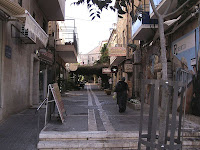 |
| The Ezrat Israel Neighbourhood Photo by Ranbar |
Ezrat Israel is a small neighbourhood tucked away between
the Jaffa Road and Rehov Hanevi’im near to the junction of Jaffa Road and King
George Street. The whole neighbourhood
consists of one narrow alley with a row of houses, originally two-storey
buildings, on either side. It was
established in 1892 on the initiative of Rabbi Ya’akov Meir the Hacham Bashi –
the Sephardi Chief Rabbi of Israel. He
was supported by a group of notable Sephardi and Ashkenazi rabbis; Rabbi
Ben-Zion Meir Hai Uziel who succeeded him in as Hacham Bashi, Rabbi Nissim Elyashar,
Rabbi Moshe Feinstein, Rabbi David Kantorowitz, Rabbi Yaakov Mann and Rabbi
Joseph Rivlin.
 |
| Nabi Okasha Mosque Photo: Yoninah |
Cabbalists considered a hill just to the north of the site
of this neighbourhood to be “Patcha DeKarta”, the entrance to the city, the
seat of the Mashiach ben Yosef who would herald the arrival of the
Messiah. Before the neighbourhood was
built a group of cabbalists, students of the Vilna Gaon, set up a tent there
(the tent of Mashiach ben Yosef) and prayed there fervently for the coming of
the Messiah. In 1908 the International
Evangelistic Church was built at the end of the neighbourhood facing Rehov
Hanevi’im where the cabbalists’ tent had been.
The tent was moved to Nabi Okasha Park on Rehov Strauss.
When the neighbourhood was first built it connected the
Jaffa Road and Rehov Hanevi’in. It was also
a convenient route between the established neighbourhoods of Even Israel and
Meah Shearim. Iron gates were installed
at both its entrances and they were locked at night. With the building of the evangelistic church
the way through to Rehov Hanevi’im and Meah Shearim was blocked.
 |
| Hacham Bashi Harav Ya'akov Meir |
Ezrat Israel though small was home to some prominent
people. The Sephardi Chief Rabbis Ya’akov
Meir and Ben-Zion Meir Hai Uziel lived there as did Yitzchak Ben Zvi, the
second President of the State of Israel and Rachel Yanait Ben Zvi. The authors Yehuda Burla and Yehuda HaEzrachi
(Brisker) grew up in the neighbourhood.
There were three print houses in Ezrat Israel. In one, the Co-operative or “Unity” printing
house, David Ben Gurion and Yosef Haim Brenner worked and at times lived. Jerusalem’s Freemasons’ Hall can still be
found in the neighbourhood. Today the little
neighbourhood contains a mixture of homes, shops and offices and has a traditional
or secular character. Take the time to
visit Ezrat Israel next time you are near the Jaffa Road. It is a quiet and picturesque oasis in the
midst of Jerusalem.
 |
| A street sign from the British Mandate Photo: DMY |
For those of you who wonder about Nabi Okasha: There is a Mamluk
mausoleum and a mosque known as Nabi Okasha or al-Kimeria on Rehov Strauss. Many traditions cling to this place. It is the grave of Okasha, a friend of the
Prophet Muhammad. It is the grave of
four sons of Kimer who fought with Saladin against the Crusaders. It is the burial place of the major prophets of
the three great Abrahamic religions: Moses, Jesus and Muhammad. That is the reason that the British Governor
Sir Ronald Storrs gave Rehov Hanev’im (the Street of the Prophets) its
name.
No comments:
Post a Comment